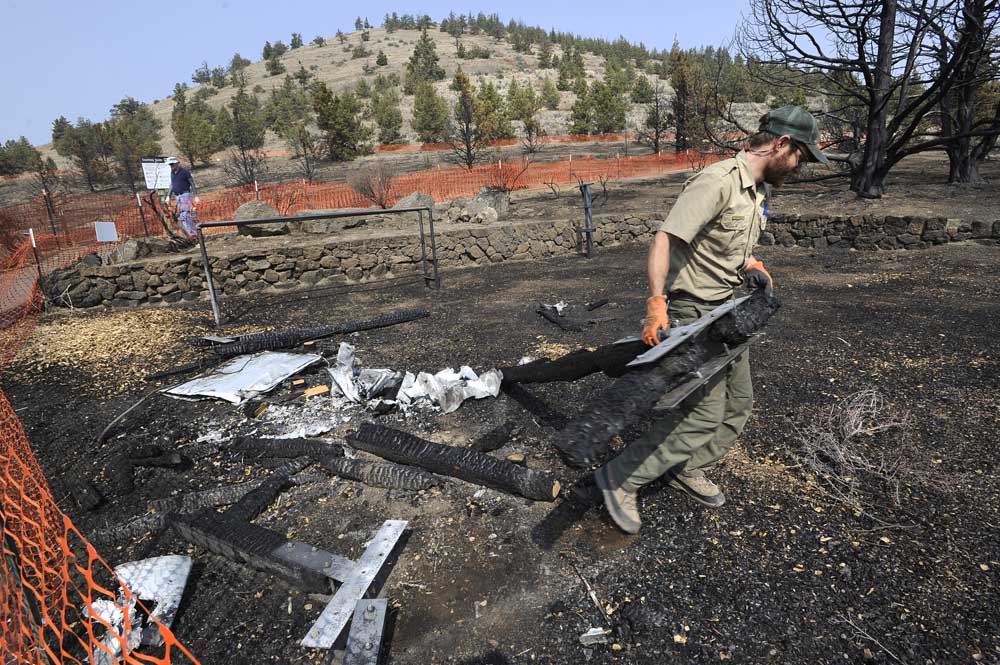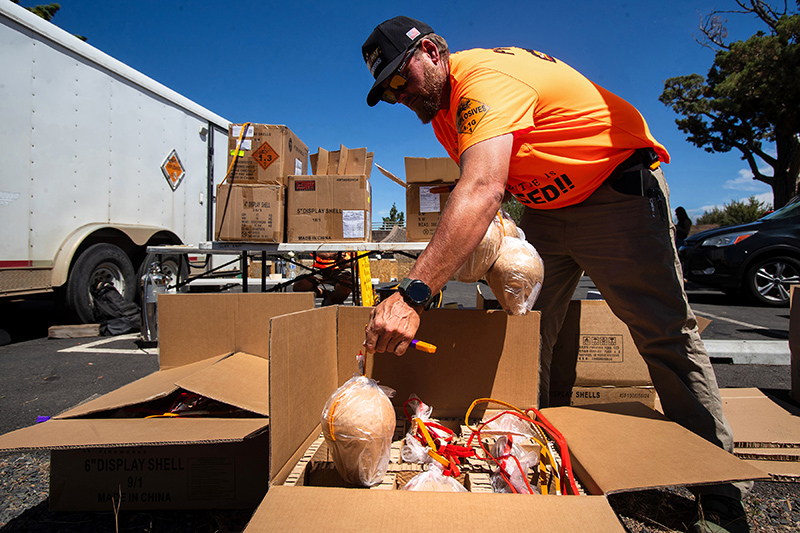Pilot Butte faces years of rehabilitation after Fourth of July fire
Published 12:00 am Monday, August 20, 2018

- (Ryan Brennecke/Bulletin photos)ABOVE: Jacob Seidel, a state park ranger, removes the burned debris of an information kiosk and workout stations near the Pilot Butte trailhead Friday. The fire was contained to roughly 10 acres after being ignited by an illegal firework on the Fourth of July. BELOW: Walkers make their way down a path through the burn scar.
About six weeks after a fire on the Fourth of July ravaged the base of Pilot Butte, mitigating the damage to the burned areas remains an uphill battle.
“It’s going to be a long process, so we appreciate everyone’s patience,” said Susan Bethers, park manager for the Tumalo management unit of the Oregon State Parks and Recreation Department, which oversees Pilot Butte.
Just before 5 p.m. on the holiday evening, a firework lit illegally by Bend resident Alan Joseph Stout sparked a fire on Bend’s iconic butte, closing U.S. Highway 20 near the fire, prompting evacuations in a couple of nearby apartment complexes and knocking out power for a good chunk of the city. The fire was ultimately contained after burning approximately 10 acres, primarily on the southern and eastern sides of the butte, according to Bend Fire Department.
The damage included dozens of scorched junipers on the butte, a destroyed informational kiosk located near the park’s main trailhead and a damaged irrigation line running underground near the park’s base trail, Bethers said.
“It’s going to be years of trying to rehabilitate that area,” she said.
The agency is still determining the cost of that rehabilitation. Bethers said the cost, along with the outcome of an insurance claim filed with the state, will help determine how the agency replaces features like the informational kiosk.
“Whether it will be the exact same, I don’t know,” Bethers said.
Before the fire stopped smoldering, natural resource specialists began partitioning off the edge of the burned area with temporary orange fencing. Bethers said the goal of the fencing was twofold, keeping visitors from getting burned by hot spots within the fire scar while preventing erosion in a vulnerable environment.
“The butte has an erosion problem in general,” she said. “And now that the vegetation is gone, that problem is going to be magnified.”
One challenge is keeping cheatgrass and other invasive vegetation from spreading within the burned area. Bethers said cheatgrass, an invasive weed that creates a fire risk by drying out earlier in the summer than many native plants, does well in environments that have been burned or have experienced some other disturbance. Keeping people out of the fire scar keeps the ground from being trampled, which Bethers said would exacerbate the disturbance.
The fire had a short-term effect on visits to Pilot Butte. Bethers said most of the park’s regular visitors returned to the hiking trails as summer wore on. The trail to the summit had been closed for the Fourth of July fireworks show but was open again by the weekend.
Going forward, Bethers said the state parks department plans to convert the temporary fencing into a more permanent enclosure around the burned area, creating an untrammeled habitat that demonstrates how the butte might have looked before Bend was settled.
“This is what the butte would look like if more of it were undisturbed,” she said.
The parks department intends to remove many — though not all — of the burned juniper trees in the area within the next month. From there, natural resource specialists will replant trees and, in all likelihood, native grasses in an effort to restore habitat on the butte.
After an event like the Pilot Butte fire, Bethers said, one of the first steps is filing an insurance claim with the Oregon Department of Administrative Services’ risk-management team. Shelly Hoffman, state risk manager for administrative services, said the state typically sends someone to assess the damage in person for significant incidents like wildfires.
She said much of the damage will likely be covered by the agency, but certain components, including damage to landscaping and irrigation, won’t be covered by the state’s plan.
Stout’s sentence is expected to include paying about $20,000 in restitution, which will go toward restoration efforts at the park, among other costs, according to The Bulletin’s archives.
Hoffman said the agency will likely have a cost estimate for damage covered by insurance within the month.
“This one’s a bit larger, so it’s likely to take longer,” Hoffman said.
— Reporter: 541-617-7818, shamway@bendbulletin.com








